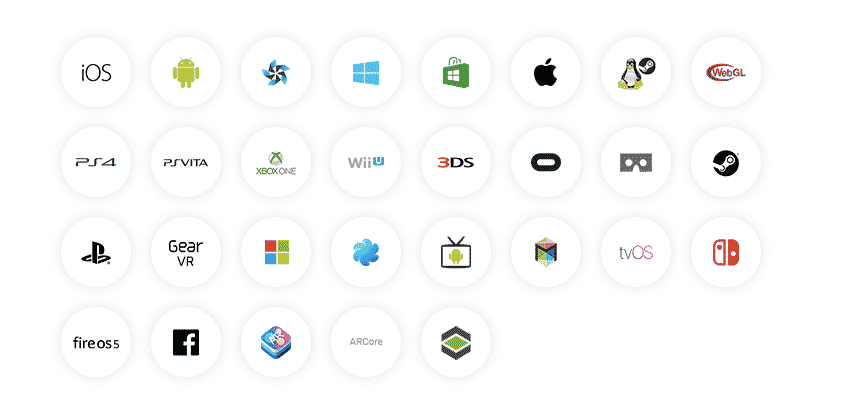Unity Technologies – The World’s Leading Game Engine
Table of contents

When you first step into a virtual reality (VR) experience, one of the most interesting things is the ability to look around in a virtual world interactively. When a video game character is standing in front of you, peering around them to check out their backpack will elicit a giggle and a feeling of thrill as you actually explore another world. Now think about how you might accomplish that with real-world video. You would need cameras coming from all four directions. But what if you wanted to look at the underside of a table, or inside a drawer? We do not have ubiquitous video recorders that can capture and replicate everything, even though we’re trying our damnedest with contraptions like this one from a company called 360 Design which we talked about in our article on Real-Time Virtual Reality (VR) – The Ultimate Experience:
In order to create a truly 3D world where every single surface is rendered for the viewer, you’ll need a development platform that lets you create virtual worlds. You may recall our article on a company called Improbable that is developing a platform called “SpatialOS” which allows you to model and create virtual worlds. This is the primitive foundation of a future where we can eventually create realistic simulations – like the one we’re living in right according to Elon Musk. And it’s not just Improbable working on this.
About Unity Technologies

It doesn’t take that long though to become somewhat awed (and perhaps a bit frightened) at how much of a footprint Unity has in gaming—not to mention its potential applications in other sectors. In short, Unity is the most popular game engine around, with innovations that could make it one of the most widely used tech companies in the world.
Market Stats
Today, Unity owns more than 45% of the game engine market according to a bunch of MBAs over at McKinsey. As The Next Web notes, that’s nearly three times the size of its nearest competitor Unreal Engine. There are more than 5 million registered Unity developers and 2.4 billion mobile devices running the platform, according to the company. And according to SourceDNA, 34% of the top 1,000 free mobile games are made with Unity. (It’s the engine behind Pokemon Go.)
The platform is even popular enough to have its own conference series, Unite, held in cities around the world. Unite Europe in Amsterdam this June attracted 1,400 attendees. In a compelling comparison made on its website, Unity estimates that its platform touches 770 million gamers all over the world, whereas Twitter has 310 million monthly active users. Though their arrival at the number is likely a bit of marketing magic, it’s hard to dispute the larger implication—gaming is an undeniable behemoth. And Unity owns 45% of it.
Product Features
So what’s so great about the Unity platform? The basics are straightforward. Offering personal (totally free), plus ($35/month), and pro ($125/month) levels, Unity’s game development engine can be used by anyone, from beginners to creators to large studios. It covers seemingly every device in existence – mobile devices, home entertainment systems, PCs, and embedded systems. Android, iOS, PlayStation, XBox, Wii, Microsoft, and many more are all buildable within the Unity platform.
The feature set of Unity 2017 is equally expansive, including graphics rendering with a real-time rendering engine, art and design tools like color grading and worldbuilding, and live operations analytics and performance reporting. In addition to the above mentioned Pokemon Go, some of the games built with Unity include Monument Valley, Rick and Morty: Virtual Rick-ality, Lara Croft GO, Life of Us, and D.R.O.N.E., just to name a few.
The company also offers a broad variety of solutions and services for “creating games, boosting productivity, and connecting with audiences”. The Asset Store offers extensions and tools for the Unity Platform to help developers build smarter and faster. A huge Learn section on its site offers courseware, certification, live training, and a knowledge base. Its Analytics services tap into the massive amount of user data in the Unity pool to help game designers understand how people interact with their games, not to mention provide a detailed view of global gaming overall.

Expanding to Other Sectors
That’s the easy stuff though. Anybody can build a game development engine that achieves global popularity (just kidding, it’s actually super hard to do). Its most recent release, Unity 2017.2, proves that the company has even bigger plans.
With a goal of making Unity more accessible to non-engineers – or ‘democratizing development,’ as the company calls it – Unity introduced two new tools this summer, Timeline and Cinemachine. Timeline enables drag-and-drop of animations in a game, and Cinemachine is a smart camera system within the game that can follow elements in a scene (it’s on a user-controlled dolly track, making it feel like you’re actually on a film set). Combined, the two technologies automate many processes of designing a game, removing much of the code needed so that just about anyone can jump in.
What’s extra interesting about these new tools is that they’re opening up whole new market sectors for Unity. Filmmaking is one of the first. To show off the technology last year, Unity unveiled a proof-of-concept short film called Adam.
The response was so enthusiastic that the company is now working with director Neill Blomkamp’s Oats Studios to turn it into a full-fledged film. The possibility of making movies without having to rely on studio resources will be too plumb to pass up for a whole new generation of directors and creators. It’s easy to see how Unity could extend its gaming domination into a decent swath of the film world.
In May of this year, Unity closed an investment from Silver Lake of $400 million, spiking its valuation to $2.6 billion. The platform’s ability to develop easily in virtual reality and augmented reality (VR/AR) – a sector expected to reach $108 billion by 2021 – places it at the leading-edge of a new frontier in software development. It goes beyond gaming and movies (not that those are tiny sectors)—VR/AR is already impacting shopping, medical research, healthcare, product development, and multiple other industries. Unity’s VR tools are sophisticated enough to meet the needs of such disparate entities as Ubisoft (game studio), Weiden+Kennedy (creative agency), and NASA (freaking NASA, man). The VR space is just starting to take off, and Unity put out an interesting report to show this:
Conclusion
While some have bandied about the idea of acquisition for Unity – there was a spate of chatter about it back in 2014 – all signs point to the company wanting to make a mark on its own terms. As DFJ investor Barry Schuler said in a May interview, “If Google or Facebook were to buy Unity, everything that makes Unity work would go away. What makes it work so well is that they are a pure play, independent company.” That sort of statement coming from an investor implies that an exit may come in the form of an IPO, something that will allow retail investors to get some exposure to the world’s leading game engine.
Sign up to our newsletter to get more of our great research delivered straight to your inbox!
Nanalyze Weekly includes useful insights written by our team of underpaid MBAs, research on new disruptive technology stocks flying under the radar, and summaries of our recent research. Always 100% free.




















It’s a shame almost none Unity’s budget goes towards actually fixing bugs (that have existed for many years, mysteriously being closed off as “fixed”) and constantly abandoning features the minute they are released in alpha-like conditions like they did with UNET and most other new features.
They are potentially amazing. All they need to do is make stable versions ACTUALLY stable and take care of existing modules that keep breaking.